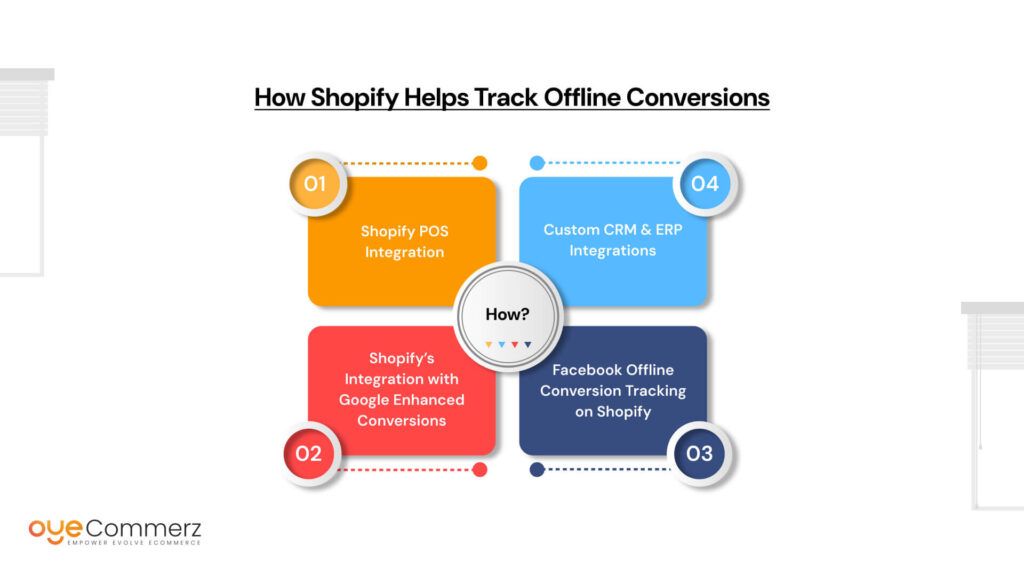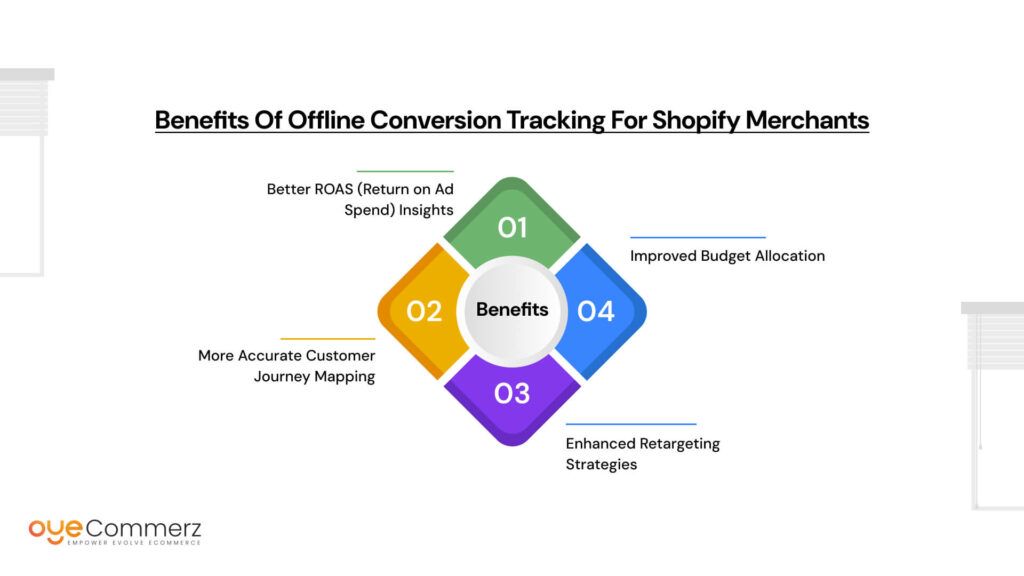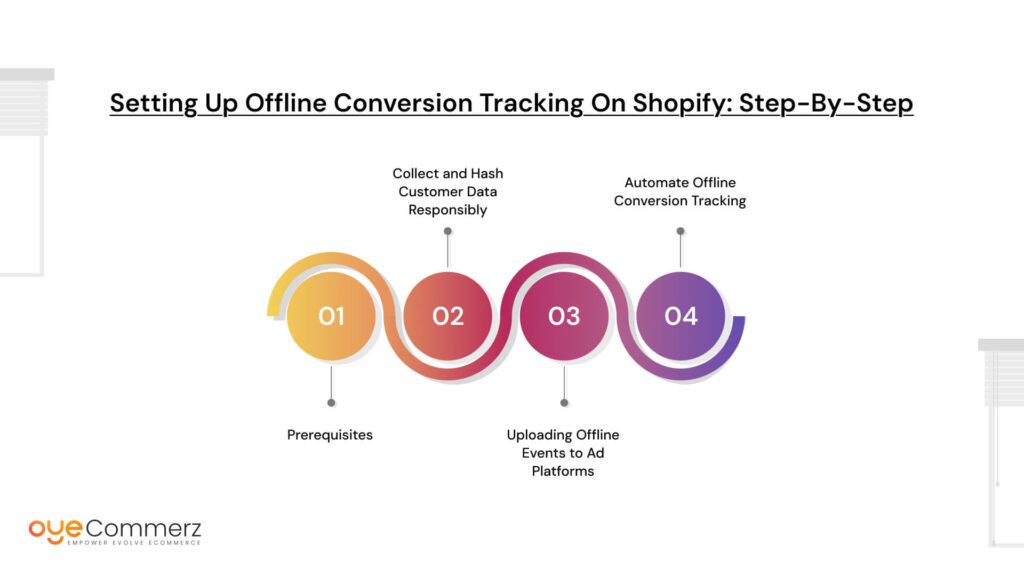Did you know that over 80% of retail sales still happen offline? Yet, most tracking tools only capture what happens online leaving a major gap in understanding the full customer journey.
For e-commerce brands, this means missed insights and misattributed ad spend.
That’s where Shopify steps in. With powerful tools and integrations, Shopify helps bridge the gap between online clicks and offline purchases giving merchants a clearer view of what’s driving results.
In this blog, we’ll break down offline conversion tracking, why it matters, and how Shopify makes it work.
Table of Contents
ToggleUnderstanding Offline Conversion Tracking
Offline conversions are customer actions that happen outside of your website, such as:
- In-store purchases
- Phone orders
- Event sign-ups or consultations
These conversions are often influenced by online marketing but completed offline.
Why They Matter in an Omnichannel E-commerce Strategy
- Bridge the gap: Many buyers research online but purchase offline.
- Accurate ROI: Helps track the real impact of digital campaigns.
- Better attribution: Understand which channels drive offline sales.
- Improved experience: Tailor marketing using online + offline behavior.
Industries That Rely on Offline Interactions
- Fashion – People prefer trying clothes in-store.
- Furniture – Shoppers want to see and feel products before buying.
- High-ticket items – Cars, jewelry, and electronics often require in-person decisions.
- Real estate & healthcare – Conversions typically happen via offline meetings or calls.
The Attribution Gap: A Persistent Challenge
What Is the Attribution Gap?
The attribution gap is the disconnect between your online marketing efforts and offline conversions. It happens when a customer interacts with your ads online but completes their purchase or action offline leaving the digital tools unable to track the full journey.
How It Affects Marketing ROI
- Undervalued campaigns: If offline sales aren’t tracked, your best-performing ads may seem ineffective.
- Misallocated budget: Without accurate attribution, ad spend may go to the wrong channels.
- Incomplete data: Marketing decisions are based on partial insights, reducing effectiveness.
Common Scenarios Where Attribution Is Lost
- A customer clicks a Google Ad for a sofa, visits your store, and buys in person.
- Someone sees a Facebook ad for a jewelry brand, calls the store, and places an order.
- A shopper browses your site, then attends an in-store event and purchases.
- A user fills an online form, then books a consultation and converts offline.
In all these cases, digital tracking tools miss the final sale.
Limitations of Traditional Online Tracking Tools
- Facebook Pixel & Google Ads Conversion Tracking
These tools track actions only on your website. Offline actions like phone orders or in-store sales go untracked unless manually uploaded. - Lack of cross-channel visibility
They can’t connect online behavior with offline events unless integrated with CRMs or POS systems. - Cookie restrictions & privacy regulations
Tracking is becoming harder with limited cookies, iOS restrictions, and privacy laws.
In short, the attribution gap hides the real value of your marketing. Without bridging this gap, businesses risk underestimating their online impact and missing growth opportunities.
How Shopify Helps Track Offline Conversions

Shopify supports offline conversion tracking by bridging the gap between online and offline customer interactions. With its ecosystem of integrations POS, advertising platforms, CRMs, and ERPs Shopify enables accurate tracking, smarter marketing decisions, and a seamless omnichannel experience.
A. Shopify POS Integration
Connecting Online and Offline Purchases in a Unified System
Shopify Point of Sale (POS) allows businesses to sell in physical locations while keeping all data in sync with their online store. When a customer buys in-store, their purchase history, behavior, and preferences are automatically linked with their online activity.
Syncing Customer Data Across Channels
- A single customer profile stores purchase history, contact info, and loyalty details from both online and offline interactions.
- This unified system allows businesses to:
- Send tailored emails based on total customer value.
- Track which online campaigns drive in-store visits.
- Reward loyalty across channels.
For example, if a user clicks an online ad, browses the site, then purchases in-store, the Shopify POS captures that sale under the same customer record.
B. Shopify’s Integration with Google Enhanced Conversions
How Shopify Passes Customer Data for Offline Conversion Imports into Google Ads
Shopify integrates directly with Google Enhanced Conversions, which allows hashed customer data (such as email or phone) from Shopify to be securely shared with Google Ads.
This lets Google match offline transactions to ad clicks even if the conversion happens in-store or over the phone.
Improved Ad Performance Reporting
- Better attribution: Offline conversions are connected to specific Google campaigns.
- Smarter optimization: Google Ads can auto-adjust bids based on both online and offline data.
- More complete ROI tracking: You know exactly how much revenue your ads are really driving, across channels.
C. Facebook Offline Conversion Tracking on Shopify
Using Facebook’s Offline Events Tool via Shopify
Shopify supports Facebook’s Offline Events API, which allows businesses to track offline purchases (e.g., in-store or phone orders) that are influenced by Facebook and Instagram ads.
Closing the Loop Between Facebook Ad Views and In-Store Sales
- Shopify can send offline purchase data to Facebook along with customer identifiers (email, phone number, etc.).
- Facebook matches these to ad interactions and reports them in your Ads Manager.
- This helps you:
- Measure offline impact of your Facebook ads.
- Optimize targeting for in-store traffic.
- Improve ad creative based on what’s converting.
For example, if someone sees a Facebook ad, visits your physical store, and buys a product, that sale can be attributed back to the ad even though it didn’t happen online.
D. Custom CRM & ERP Integrations
Leveraging APIs to Push Offline Sales Data Back to Platforms Like Meta, Google, or Klaviyo
Shopify offers a robust API that allows you to send offline sales data from your POS or third-party systems (ERP, CRM) back to major ad platforms and email tools.
You can:
- Sync data with Meta Ads (via Conversions API)
- Feed Google Ads offline conversion imports
- Push enriched customer data to Klaviyo for automated flows and segmentation
Benefits for Businesses Using CRMs (HubSpot, Salesforce, etc.)
For businesses running complex sales processes or high-ticket sales, CRMs like Salesforce or HubSpot are critical. Shopify integrations allow:
- Offline events (like closed deals, calls, in-person meetings) to be connected with marketing data.
- Better lead nurturing via email/SMS based on total customer activity.
- Unified analytics across sales, marketing, and support.
This means your entire customer journey from ad click to in-store visit to post-sale engagement is tracked, personalized, and actionable.
Benefits of Offline Conversion Tracking for Shopify Merchants

Tracking offline conversions provides Shopify merchants with powerful insights and capabilities that improve marketing performance, customer understanding, and resource allocation. Here’s how:
1. Better ROAS (Return on Ad Spend) Insights
One of the biggest challenges for merchants is accurately measuring how much revenue their digital ads actually generate. Many sales influenced by online ads happen offline like in-store purchases or phone orders which traditional online tracking tools often miss.
Offline conversion tracking bridges this gap by attributing offline sales back to the ads that influenced them. This gives merchants:
- A more complete and accurate ROAS, reflecting total sales rather than just online transactions.
- The ability to identify which campaigns, keywords, or ads drive real revenue, not just clicks or website visits.
- Insights to justify or scale up ad spend on campaigns proven to deliver offline results.
Ultimately, this leads to smarter marketing investments and higher overall profitability.
2. More Accurate Customer Journey Mapping
The modern customer journey rarely happens entirely online or offline; it’s a blend of multiple touchpoints across channels.
Offline conversion tracking allows Shopify merchants to:
- Connect the dots between initial ad impressions, online browsing, and offline purchases.
- Understand how customers move through stages like research, store visits, consultations, and final purchase.
- Gain insight into offline behaviors such as in-store upsells, repeat visits, or offline service usage.
This holistic view helps merchants understand which marketing efforts truly influence buying decisions, enabling better targeting and messaging that aligns with real customer behavior.
3. Enhanced Retargeting Strategies
Knowing who has already converted offline allows merchants to tailor their retargeting campaigns more effectively:
- Exclude offline converters from retargeting ads, reducing wasted ad spend on customers who already purchased.
- Build lookalike audiences based on customers who converted offline, improving targeting precision for acquiring new customers.
- Personalize follow-up ads or email marketing campaigns based on the full purchase history (both online and offline), which can boost customer lifetime value.
This enhanced targeting means higher engagement, better conversion rates, and more efficient use of marketing budgets.
4. Improved Budget Allocation
With visibility into both online and offline conversions, merchants can make informed decisions on where to allocate their marketing budget for maximum impact:
- Shift spend to the most profitable channels and campaigns driving total sales.
- Reduce investment in campaigns that generate clicks but little offline revenue.
- Optimize creative and messaging based on which ads lead to offline sales.
- Justify investment in omnichannel strategies by showing the real revenue uplift.
This data-driven budget allocation helps merchants get the most out of their marketing dollars and avoid spending on ineffective tactics.
Setting Up Offline Conversion Tracking on Shopify: Step-by-Step
Step 1: Prerequisites
Before you start, ensure you have the following set up:
- Shopify POS: To capture offline in-store sales and customer data.
- Google Ads Account: For importing offline conversions via Google Enhanced Conversions.
- Facebook Business Manager & Ads Account: To use Facebook Offline Events and track in-store sales driven by Facebook ads.
- Access to Customer Data: Email addresses, phone numbers, or other identifiers from customers for matching offline events.
- Optional: CRM or ERP systems for advanced data syncing.
Step 2: Collect and Hash Customer Data Responsibly
Offline conversion tracking requires sharing customer data with ad platforms to match offline sales with online interactions. For privacy and compliance:
- Collect relevant customer identifiers at checkout or POSvlike email, phone number, or mailing address.
- Hash customer data (convert to encrypted format using SHA-256) before sending it to ad platforms. Shopify and many integrations do this automatically to protect privacy.
- Ensure compliance with data privacy laws (GDPR, CCPA) and inform customers how their data will be used.
Step 3: Uploading Offline Events to Ad Platforms
Depending on the platform, offline events can be uploaded manually or automatically:
a. Google Ads (Enhanced Conversions & Offline Conversion Imports)
- Shopify can automatically send hashed customer data via Enhanced Conversions.
- For offline sales from Shopify POS or external sources, prepare a CSV file with purchase details (transaction ID, date, value, customer info).
- Upload offline conversion data via Google Ads interface or use the Google API.
- Google matches these events to ad clicks for accurate attribution.
b. Facebook Offline Events
- Connect Shopify with Facebook Offline Events via Shopify’s Facebook channel or third-party apps.
- Facebook receives hashed customer info and offline transaction data automatically or via manual uploads.
- Facebook matches offline sales to people who saw or clicked your ads, closing the attribution loop.
Step 4: Automate Offline Conversion Tracking
To simplify ongoing tracking:
- Use Shopify apps like Trackify, Littledata, or Elevar that integrate with Google and Facebook for automated offline conversion syncing.
- Set up custom scripts or middleware to pull offline sales data from POS or CRM and push it to advertising platforms using their APIs.
- Automations ensure real-time or scheduled uploads, keeping your data fresh without manual effort.
Data Privacy and Consent (Short Version)
Compliance with GDPR, CCPA, and Other Laws
- Always collect clear consent before using customer data for tracking or marketing.
- Provide customers with easy opt-out options and respect their data rights.
- Use only necessary data, and keep it secure and transparent.
- Maintain records of consent to comply with regulations.
Shopify’s Tools for Privacy and Consent
- Built-in cookie consent banners and customizable privacy policies.
- Automatic hashing of customer data before sharing with ad platforms.
- Apps available for managing GDPR/CCPA compliance and consent automation.
- Customer controls to update or delete personal data through Shopify.
Future of Attribution: Unified Commerce with Shopify
Predictive Analytics and AI-Powered Insights
Shopify is increasingly leveraging predictive analytics and AI technologies to help merchants anticipate customer behavior and optimize marketing efforts.These advanced tools analyze data from multiple sources online and offline to predict:
- Which customers are most likely to convert or churn
- The best channels and times to engage buyers
- Future sales trends based on historical data and market signals
This lets merchants make proactive, data-driven decisions, improving both marketing ROI and customer experience.
Expanding Attribution Beyond Last-Click
Traditional attribution models like last-click don’t capture the full customer journey, especially in omnichannel retail. The future of attribution focuses on:
- Multi-touch attribution that credits all key interactions across channels
- Tracking offline interactions alongside online behaviors
- Integrating data from POS, CRM, social media, email, and ads into one comprehensive model
Shopify’s evolving platform supports these sophisticated attribution methods, enabling merchants to understand the true impact of every marketing touchpoint.
Shopify’s Ecosystem Evolving for Deeper Customer Understanding
Shopify continues to build an interconnected ecosystem that brings together:
- POS systems for offline sales data
- Third-party apps and integrations for marketing, CRM, and analytics
- APIs and data-sharing tools for seamless syncing across platforms
This unified commerce approach allows merchants to gain a 360-degree view of customers, breaking down silos between online and offline data.
The result is a richer, more accurate understanding of customer behavior and stronger, more personalized marketing strategies.
Ready to Track Every Sale and Boost Your ROI?
Accurately measuring offline conversions is key to unlocking the full potential of your marketing efforts. If you’re unsure how to set up offline conversion tracking on Shopify or want to optimize your current system, Oyecommerz is here to help.
Our team of Shopify experts will guide you through seamless integration of your POS, ad platforms, and customer data ensuring you never miss a sale, whether online or offline.
Contact Oyecommerz today for customized Shopify solutions tailored to your business needs. Let us help you close the attribution gap, improve your marketing ROI, and grow your brand across all channels.
Start maximizing your omnichannel performance now!
Contact to Migrate your Site to Shopify Now
Conclusion
Closing the attribution gap is vital for merchants who want to accurately measure how their marketing efforts drive real sales, both online and offline. Many important customer actions like in-store purchases or phone orders often go untracked, leading to incomplete data and less effective marketing decisions.
Shopify simplifies offline conversion tracking by integrating its POS system with popular advertising platforms like Google Ads and Facebook. This seamless connection allows merchants to unify online and offline data, providing a clearer picture of customer behavior and campaign performance.
By leveraging Shopify’s offline conversion tools, merchants can improve their return on ad spend, optimize targeting, and allocate budgets more effectively. If you want to unlock the full potential of your marketing strategy and grow your business across all channels, it’s time to explore Shopify’s offline tracking solutions and start bridging the attribution gap today.
Frequently Asked Questions
Offline conversion tracking is the process of measuring actions that happen outside your website, such as in-store purchases, phone orders, or event signups, and linking them back to online marketing efforts. It helps businesses understand the full impact of their advertising across both digital and physical touchpoints.
One effective way is by collecting customer data (like email or phone number) at the point of offline sale and then uploading that data to ad platforms like Google Ads or Facebook. These platforms can match the data to users who clicked on or viewed your ads completing the attribution loop.
To measure offline conversions:
Capture key customer data during offline interactions (POS, phone, events).
Hash and securely upload that data to platforms like Google Ads or Facebook via offline conversion tracking tools.
Use analytics dashboards to track matched conversions and analyze campaign performance.
Track offline leads by:
Using CRM tools (like HubSpot or Salesforce) to log leads from phone calls, in-person visits, or form submissions.
Integrating your CRM with ad platforms or Shopify to sync offline data back to your marketing campaigns.
Applying unique promo codes, call tracking numbers, or lead forms that can be tied back to specific ad channels.




